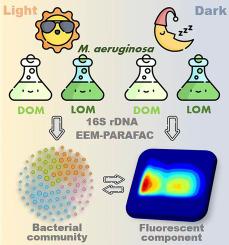Light-driven differences in bacterial networks and organic matter decomposition: Insights from an analysis of the harmful cyanobacterium Microcystis aeruginosa PCC 7806
IF 5.5
1区 生物学
Q1 MARINE & FRESHWATER BIOLOGY
引用次数: 0
Abstract
Freshwater systems are critical yet often underestimated components of global carbon cycling, functioning both as carbon sinks and sources. Cyanobacteria play a key role in this cycle by capturing atmospheric carbon dioxide through photosynthesis. The captured carbon is either released back into the atmosphere or sequestered in sediments following organismal decay. This study examines the pivotal role of cyanobacteria, specifically Microcystis aeruginosa PCC 7806, in the biogeochemical cycling of carbon in freshwater ecosystems, with a focus on how light influences the degradation of cyanobacteria-derived organic matter. Using a combination of 16S rDNA sequencing and excitation-emission matrix coupled with parallel factor (EEM-PARAFAC) analysis, we conducted a 50-day experiment to investigate the dynamics of dissolved organic matter (DOM) and lysate organic matter (LOM) derived from M. aeruginosa PCC 7806 under light and dark conditions. Our results demonstrate that light significantly impacts bacterial community composition, gene functionality, and the decomposition of organic matter. The findings emphasize the crucial role of light in facilitating microbial adaptation, stabilizing microbial networks and driving organic substrate transformation. These insights underscore the influence of light on microbial community dynamics and organic matter degradation, revealing shifts in microbial populations under varying light conditions. This suggests a strong link between photochemical processes and microbial activity, with significant ecological implications.

细菌网络和有机物分解中的光驱动差异:分析有害蓝藻微囊藻 PCC 7806 的启示
淡水系统是全球碳循环的重要组成部分,但往往被低估,它既是碳汇,也是碳源。蓝藻通过光合作用捕获大气中的二氧化碳,在这一循环中发挥着关键作用。捕获的碳要么被释放回大气中,要么在生物体衰变后被封存在沉积物中。本研究探讨了蓝藻(特别是铜绿微囊藻 PCC 7806)在淡水生态系统碳的生物地球化学循环中的关键作用,重点是光如何影响蓝藻衍生有机物的降解。利用 16S rDNA 测序和激发-发射矩阵耦合并行因子(EEM-PARAFAC)分析相结合的方法,我们进行了一项为期 50 天的实验,研究在光照和黑暗条件下铜绿微囊藻 PCC 7806 产生的溶解有机物(DOM)和裂解有机物(LOM)的动态变化。我们的研究结果表明,光照对细菌群落组成、基因功能和有机物分解有重大影响。这些发现强调了光在促进微生物适应、稳定微生物网络和推动有机基质转化方面的关键作用。这些见解强调了光对微生物群落动态和有机物降解的影响,揭示了不同光照条件下微生物种群的变化。这表明光化学过程与微生物活动之间存在密切联系,具有重要的生态影响。
本文章由计算机程序翻译,如有差异,请以英文原文为准。
求助全文
约1分钟内获得全文
求助全文
来源期刊

Harmful Algae
生物-海洋与淡水生物学
CiteScore
12.50
自引率
15.20%
发文量
122
审稿时长
7.5 months
期刊介绍:
This journal provides a forum to promote knowledge of harmful microalgae and macroalgae, including cyanobacteria, as well as monitoring, management and control of these organisms.
 求助内容:
求助内容: 应助结果提醒方式:
应助结果提醒方式:


